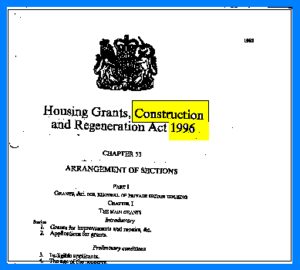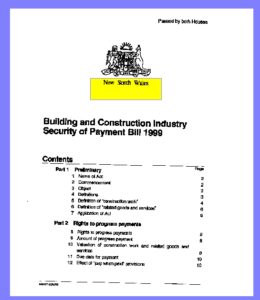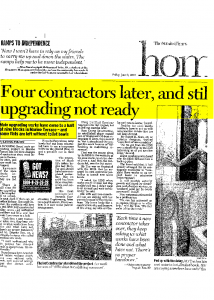Campaign for BCSOP Act
In the aftermath of the 1998 financial crisis, the Singapore construction industry faced many problems. Main contractors were financially strapped. They defaulted in payments to sub-contractors. Standard form contracts in use protected main contractors with a ‘pay-when-paid” clause.
 The clause was unfair. It prevented many disputes over sub-contractor’s quality of work from being resolved by litigation. A common scenario was a developer who withheld payment because of alleged defective work. But only a small portion of the payment withheld represented main contractor’s income. The larger portion represented value of sub-contract work. Because of the ‘pay-when-paid’ clause, the sub-contractor was not entitled to sue for the value of sub-contract work when the developer had not paid the main contractor for it.
The clause was unfair. It prevented many disputes over sub-contractor’s quality of work from being resolved by litigation. A common scenario was a developer who withheld payment because of alleged defective work. But only a small portion of the payment withheld represented main contractor’s income. The larger portion represented value of sub-contract work. Because of the ‘pay-when-paid’ clause, the sub-contractor was not entitled to sue for the value of sub-contract work when the developer had not paid the main contractor for it.
On the other hand, the main contractor had little incentive to sue the developer because their portion of the payment withheld was small. The result was that the dispute over quality could not be resolved by the court system. Sub-contractors had no avenue for redress.
 Meanwhile, developers had little information on the financial health of the main contractors to whom they entrusted their multi-million dollar projects. Developers did not know whether their main contractors were paying the sub-contractors. When main contractors collapsed, work on projects ground to a halt suddenly and developers were saddled with the additional cost and expense of opening tender for replacement contractors and delays.
Meanwhile, developers had little information on the financial health of the main contractors to whom they entrusted their multi-million dollar projects. Developers did not know whether their main contractors were paying the sub-contractors. When main contractors collapsed, work on projects ground to a halt suddenly and developers were saddled with the additional cost and expense of opening tender for replacement contractors and delays.
A group of six trade associations approached our Eric Ng Yuen for help in year 2000. Together with the six trades associations, Eric first approached the Singapore Institute of Architects (“SIA”) to amend their standard form contract. This request was turned down.
Next, Eric and the six associations turned to the Building and Construction Authority (“BCA”). But BCA declined to help. The standard form contract was a matter of private contract and BCA had no jurisdiction over SIA on contract matters.
 Eric decided to look at the construction laws of various countries for inspiration. It transpired that many countries faced similar problems over the previous decade. The United Kingdom passed their Housing Grant Construction and Regeneration Act in 1996. This inspired New South Wales in Australia to pass their Security of Payment Act in 1999. Over in the United States, main contractors had to abide by a code of practice. Main contractors who breached their payment obligations to sub-contractors in the US might find difficulty in renewing their licence to continue their business
Eric decided to look at the construction laws of various countries for inspiration. It transpired that many countries faced similar problems over the previous decade. The United Kingdom passed their Housing Grant Construction and Regeneration Act in 1996. This inspired New South Wales in Australia to pass their Security of Payment Act in 1999. Over in the United States, main contractors had to abide by a code of practice. Main contractors who breached their payment obligations to sub-contractors in the US might find difficulty in renewing their licence to continue their business
Based on this research, Eric prepared two Reports on the Construction Industry that were forwarded to BCA, advocating amongst other things : the security of payment legislation, licensing and code of practice to be introduced in Singapore. Initially BCA was not receptive.
Meanwhile, the construction industry deteriorated. Main contractors continued to default in payment to sub-contractors. Several main contractor companies collapsed financially. Public projects were halted and delays to the Housing Development Board’s projects caused great inconvenience to the public. This brought the unhappy state of the construction industry to the attention of the Ministers.
A public debate in the newspapers followed. Following the publicity, four to six other trades associations joined the six associations’ campaign. With the combined ten to twelve associations, Eric approached various members of parliament for assistance and support. When a succession of main contractors abandoned a Marine Parade housing project, Eric prepared a letter to the press in 2003 to highlight the unfair nature of SIA’s standard form contract. It was no longer a private contract issue. The inequitable contract system was a systemic failure that permeated the whole of the construction industry.
Soon thereafter, BCA became more receptive to the Associations’ campaign. They dispatched a team to New South Wales to study their Security of Payment Act. On their return, BCA convened a ten month long consultation with stakeholders within the construction industry. Various players such as the Singapore Contractors Association Limited (“SCAL”) opposed the new legislation. The stakeholders consultation became a heated debate. The turning point came when Eric posed the scenario described at paragraphs 1 to 3 above to SCAL. SCAL’s response showed that main contractors were wary of challenging developer’s opinion on quality of sub-contractor’s work unless there was “clear cut” evidence that the developer was wrong. In the nature of things, there was seldom “clear cut” evidence. A contract system that prevented disputes from reaching the Court was a systemic failure.
 The Building and Construction Industry (Security of Payment) Act was eventually passed in 2004 and came into operation in 2005. Up to the end of 2008, there were approx. 150 adjudication cases. Not all were filed by sub-contractors. A few were filed by main contractors and consultants against developers/owners of land. This shows that the Security of Payment Act was a benefit to the whole construction industry. It ensured a more equitable flow of payment from developer to main contractor to sub-contractor as well as consultants. The payment mechanism alerts developers promptly if a main contractor is facing financial difficulties and is not paying his sub-contractors. It levels the playing field so that all players compete fairly without resort to unfair payment practices.
The Building and Construction Industry (Security of Payment) Act was eventually passed in 2004 and came into operation in 2005. Up to the end of 2008, there were approx. 150 adjudication cases. Not all were filed by sub-contractors. A few were filed by main contractors and consultants against developers/owners of land. This shows that the Security of Payment Act was a benefit to the whole construction industry. It ensured a more equitable flow of payment from developer to main contractor to sub-contractor as well as consultants. The payment mechanism alerts developers promptly if a main contractor is facing financial difficulties and is not paying his sub-contractors. It levels the playing field so that all players compete fairly without resort to unfair payment practices.
The new Act also sets up a new dispute resolution mechanism for the construction industry. By this new mechanism, a claimant is required to stake his claim in a certain format and the respondent is required to indicate his response with details of reasons and calculations. In the event that the claimant is not satisfied with the response, a nominating body appoints an adjudicator who must make his determination on the dispute generally within fourteen days. This speeds up the dispute resolution process considerably with consequent savings in time, legal costs and expenses. This benefit accrued to the industry as a whole.
copyright @ Malkin & Maxwell LLP


